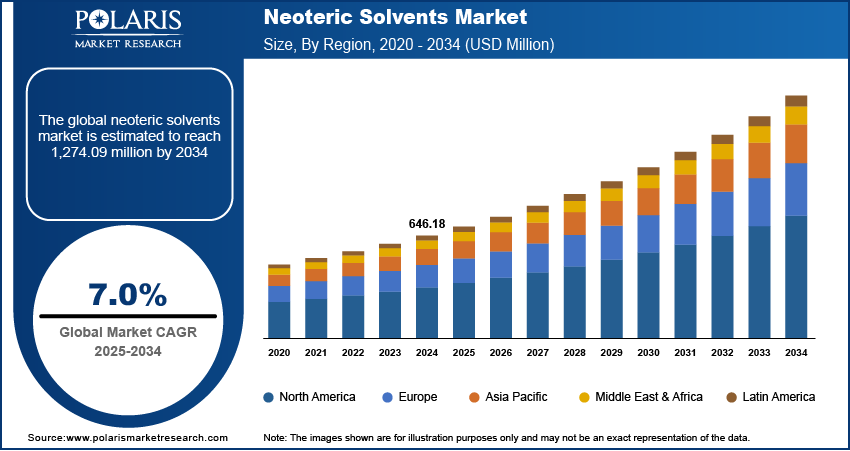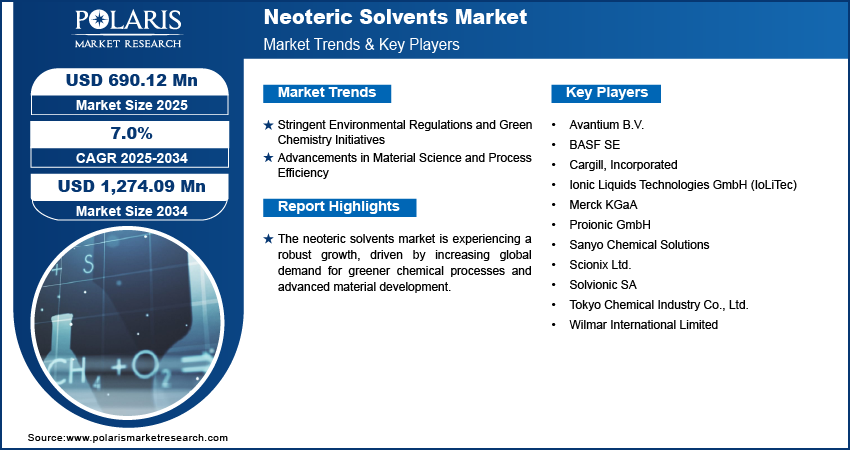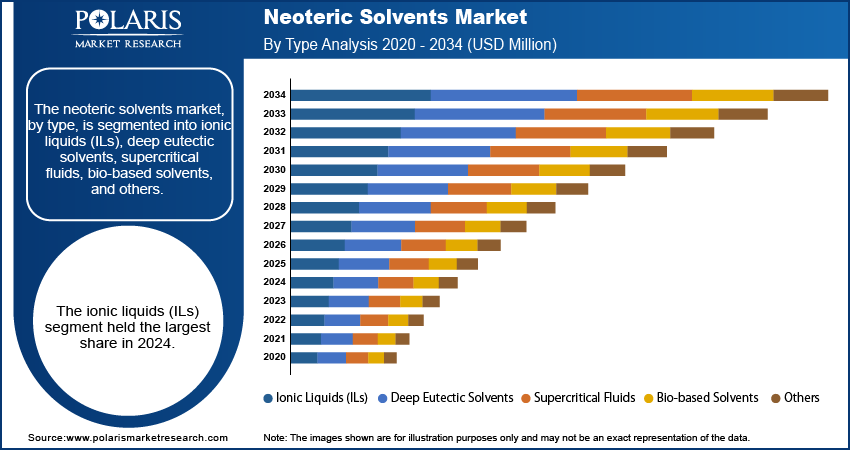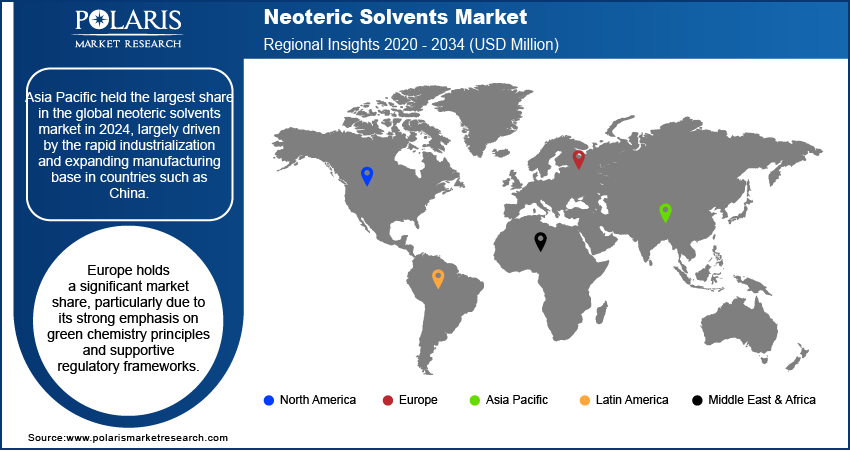
Neoteric Solvents Market Size, Share, Trends, & Industry Analysis Report
By Type [Ionic Liquids (ILs), Deep Eutectic Solvents, Supercritical Fluids, Bio-Based Solvents, and Others], By Application, By Region – Market Forecast, 2025–2034
- Published Date:Jun-2025
- Pages: 130
- Format: PDF
- Report ID: PM5738
- Base Year: 2024
- Historical Data: 2020-2023
Market Overview
The neoteric solvents market size was valued at USD 646.18 million in 2024. The market is projected to grow from USD 690.12 million in 2025 to USD 1,274.09 million by 2034, exhibiting a CAGR of 7.0% during 2025–2034.
The neoteric solvents encompass a diverse category of solvents that represent a significant departure from traditional volatile organic compounds (VOCs). These advanced solvents, including ionic liquids (ILs), deep eutectic solvents (DESs), supercritical fluids, and bio-based solvents, are characterized by their unique properties such as negligible volatility, high thermal and chemical stability, tunability, and often, low toxicity and biodegradability. Their inherent advantages over conventional counterparts are driving their increasing adoption across various applications, marking a pivotal shift toward more sustainable and efficient chemical processes. This evolving landscape is seeing continuous development, aiming to address the limitations of conventional solvents and align with global green chemistry principles.
The growing emphasis on green chemistry and sustainability across the world boosts the demand for neoteric solvents. Regulatory bodies and consumer demand are increasingly pushing industries to reduce their environmental footprint, particularly concerning the use and disposal of hazardous chemicals. They offer a compelling solution by providing alternatives with lower toxicity, reduced emissions, and enhanced recyclability. For instance, deep eutectic solvents (DESs) are gaining considerable traction due to their ease of preparation from readily available, often natural, and inexpensive components, alongside their tunable physicochemical properties. This allows for their customization to suit specific applications, such as the extraction of bioactive compounds from natural sources, without the need for traditional, often harmful, organic solvents. Their biodegradable nature further reinforces their appeal in an era focused on environmental responsibility.
The use of neoteric solvents helps enhance process efficiency and product quality across various applications, which drivers their adoption. Unlike conventional solvents that often present limitations in terms of solubility, selectivity, or reaction conditions, neoteric solvents can be engineered to possess specific properties. For example, ionic liquids are known for their exceptional solvent properties, particularly in biomass processing. They enable the mild and selective dissolution of biopolymers such as cellulose and lignin, facilitating the extraction of high-value compounds and improving biofuel production yields. This capability to process complex feedstocks with higher efficiency and lower energy consumption, while simultaneously minimizing waste, positions neoteric solvents as essential tools for optimizing industrial processes and developing novel products with superior characteristics.

To Understand More About this Research: Request a Free Sample Report
Industry Dynamics
Stringent Environmental Regulations and Green Chemistry Initiatives
Growing global awareness of environmental protection and stringent regulations are major drivers for the adoption of these solvents. Governments and international bodies are increasingly implementing policies to limit VOC emissions and promote sustainable practices in the chemical industry. For instance, a report by the European Environment Agency in 2023 highlighted a continued push for reducing hazardous substances in industrial processes, encouraging the shift toward safer alternatives such as neoteric solvents. This regulatory pressure directly incentivizes industries to invest in and integrate these innovative solvents. The rising focus on greener solvents and chemical manufacturing, reducing waste, and minimizing the carbon footprint is significantly expanding the demand for sustainable solvent solutions, such as neoteric solvents.
Advancements in Material Science and Process Efficiency
Innovations in material science are profoundly influencing the development and application of these solvents, leading to enhanced process efficiency. The ability to design and tailor specific properties of these solvents, such as viscosity, polarity, and solubility, is opening up new avenues for their use in complex chemical reactions and separations. A review published in the International Journal of Minerals, Metallurgy and Materials in 2024 detailed the significant advancements in using deep eutectic solvents (DESs) for the separation and purification of critical metals, highlighting their advantages over conventional organic solvents in terms of low toxicity and degradability. This continuous evolution in tailoring neoteric solvents for specific industrial needs, leading to improved yields and purity, is a strong growth.
Increasing Demand for Sustainable and Bio-Based Products
The rising consumer and industrial demand for sustainable and bio-based products is another crucial driver. This demand extends beyond the final product to the manufacturing processes themselves, necessitating the use of eco-friendly components such as neoteric solvents. Research published in Materials Science and Engineering in 2022 showcased the successful application of deep eutectic solvents in extracting bioactive compounds from natural sources, demonstrating their potential in pharmaceutical and cosmetic applications. The emerging trend toward circular economy principles and the utilization of renewable resources is directly fueling the adoption and development of such solvents across various consumer and industrial sectors.

Segmental Insights
Market Assessment By Type
By type, the segmentation includes ionic liquids (ILs), deep eutectic solvents, supercritical fluids, bio-based solvents, and others. Each of these solvent classes offers distinct advantages, contributing to their varied applications and differing rates of adoption. The ionic liquids (ILs) segment held the largest share in 2024. Their dominance is driven by their exceptional properties, including negligible vapor pressure, high thermal and chemical stability, and tunable solvation capabilities. These characteristics make ILs highly versatile, finding extensive use in diverse applications such as chemical processing, pharmaceuticals, energy, and agriculture. The ability to customize their cation and anion combinations allows for targeted functionalities, enhancing their utility in specific industrial processes. This adaptability and broad applicability solidify their position as a leading segment within the neoteric solvents industry.
The bio-based solvents segment is projected to experience the highest growth rate during the forecast period, driven by the increasing global demand for sustainable and renewable chemical alternatives. As industries and consumers prefer environmentally friendly solutions, bio-based solvents, derived from natural and renewable sources, offer a compelling answer to concerns regarding petrochemical reliance and environmental impact. Their inherent biodegradability and lower toxicity profiles, coupled with continuous advancements in extraction and purification technologies, are making them increasingly attractive. The drive toward circular economy principles and greener manufacturing processes is significantly boosting the potential and penetration of bio-based solvents across various applications.
Market Evaluation By Application
By application, the segmentation includes pharmaceuticals & life sciences, chemical & industrial processing, energy & electronics, agriculture, and others. The pharmaceuticals & life sciences segment held the largest share in 2024. This dominance is attributed to the critical need for highly pure, efficient, and green technologies and processes in drug discovery, development, and manufacturing. Neoteric solvents, including ionic liquids and deep eutectic solvents, offer superior capabilities in dissolving poorly soluble active pharmaceutical ingredients (APIs), enhancing reaction selectivity, and facilitating efficient separation and purification steps. Their tunability allows for precise control over crystallization processes and the extraction of sensitive biomolecules, aligning with the stringent quality and regulatory requirements of this application area.
The energy & electronics segment is poised to exhibit the highest growth rate during the forecast period. The growth is fueled by the rapid advancements and increasing demand in sectors such as renewable energy technologies, advanced battery systems, and semiconductor manufacturing. Neoteric solvents are crucial for developing next-generation electrolytes for batteries, enabling more efficient energy storage and delivery. In electronics, their nonvolatile nature and high thermal stability are beneficial for precise cleaning, etching, and deposition processes. The increasing focus on miniaturization, enhanced performance, and environmental sustainability within the energy and electronics landscapes is significantly driving the adoption and innovation of neoteric solvents in these critical applications.

Regional Analysis
The geographical landscape of the neoteric solvents market is diverse, reflecting varying regulatory environments, industrial concentrations, and research and development focuses across major regions. These regions include North America, Europe, Asia Pacific, Latin America, and the Middle East & Africa. The adoption of neoteric solvents is attributed to regional commitments to sustainability, technological advancements, and the specific demands of dominant industries such as pharmaceuticals and industrial cleaning industries in each area. This regional analysis provides critical insights into the localized drivers and trends shaping the global outlook for neoteric solvents.
The Asia Pacific neoteric solvents market holds a significant position globally with the largest share, largely driven by the rapid industrialization and expanding manufacturing base in countries such as China. The region's stringent environmental regulations, such as China's "Blue Sky" initiatives, are compelling chemical manufacturers to reduce VOC emissions and adopt more sustainable alternatives such as ionic liquids and deep eutectic solvents. The robust growth in the electronics, semiconductor, and battery manufacturing sectors within China further fuels the demand for high-performance, eco-friendly solvents for precision cleaning, etching, and other critical processes. This strong combination of industrial expansion and regulatory pressure propels the China neoteric solvents market growth.
The Europe neoteric solvents market accounts for a significant share, particularly due to its strong emphasis on green chemistry principles and supportive regulatory frameworks. The Germany neoteric solvents market held the largest share in Europe in 2024, as the country has advanced chemical industry and a robust research and development ecosystem. The nation's commitment to reducing environmental impact and fostering sustainable manufacturing processes drives the widespread adoption of bio-based solvents, deep eutectic solvents, and supercritical fluids. German companies are actively investing in innovation to produce and utilize these solvents across pharmaceuticals, specialty chemicals, and advanced materials applications, often seeking to replace traditional and more hazardous organic solvents. This proactive approach to sustainability and innovation solidifies Germany's, and by extension, Europe's, prominent role in driving the adoption of neoteric solvents.

Key Players and Competitive Insights
The neoteric solvents market includes a few key players such as BASF SE; Merck KGaA; Ionic Liquids Technologies GmbH (IoLiTec); Solvionic SA; Proionic GmbH; Scionix Ltd.; Tokyo Chemical Industry Co. Ltd.; Sanyo Chemical Solutions; Avantium B.V.; Cargill, Incorporated; and Wilmar International Limited. These organizations are actively involved in the development, production, and distribution of various types of neoteric solvents, catering to a wide range of applications.
The competitive landscape within the market is characterized by a mix of large chemical conglomerates and specialized companies. Established chemical manufacturers leverage their extensive research and development capabilities, global distribution networks, and existing client relationships to maintain their presence. Smaller, more specialized firms often focus on niche applications or specific types of neoteric solvents, differentiating themselves through innovative processes or tailored solutions. Collaboration between academic institutions and key players is also a notable trend, accelerating the commercialization of new solvent technologies. The increasing focus on sustainability and the push for greener chemical processes continue to shape competitive strategies, with companies striving to offer solutions that meet both performance and environmental criteria.
List of Key Companies
- Avantium B.V.
- BASF SE
- Cargill, Incorporated
- Ionic Liquids Technologies GmbH (IoLiTec)
- Merck KGaA
- Proionic GmbH
- Sanyo Chemical Solutions
- Scionix Ltd.
- Solvionic SA
- Tokyo Chemical Industry Co., Ltd.
- Wilmar International Limited
Industry Developments
- August 2023: Proionic GmbH introduced HIPE-REC technology—a significant innovation for the efficient recovery and recycling of distillable ionic liquids used in biomass processing. This approach leverages specially tailored ionic liquids and a thin-film, high-viscosity evaporation system to address past limitations related to high energy demands and contamination, achieving recovery rates exceeding 99% even in highly viscous biomass environments.
- September 2020: Gattefossé enhanced its eco-certified product line by launching Gatuline RC Bio and EleVastin, two personal care ingredients developed through sustainable processes, including extraction using NaDES (natural deep eutectic solvents).
Neoteric Solvents Market Segmentation
By Type Outlook (Revenue – USD Million, 2020–2034)
- Ionic Liquids (ILs)
- Deep Eutectic Solvents
- Supercritical Fluids
- Bio-based Solvents
- Others
By Application Outlook (Revenue – USD Million, 2020–2034)
- Pharmaceuticals & Life Sciences
- Chemical & Industrial Processing
- Energy & Electronics
- Agriculture
- Others
By Regional Outlook (Revenue – USD Million, 2020–2034)
- North America
- US
- Canada
- Mexico
- Europe
- Germany
- France
- UK
- Italy
- Spain
- Netherlands
- Russia
- Rest of Europe
- Asia Pacific
- China
- Japan
- India
- Malaysia
- South Korea
- Indonesia
- Australia
- Vietnam
- Rest of Asia Pacific
- Middle East & Africa
- Saudi Arabia
- UAE
- Israel
- South Africa
- Rest of Middle East & Africa
- Latin America
- Brazil
- Argentina
- Rest of Latin America
Neoteric Solvents Market Report Scope
|
Report Attributes |
Details |
|
Market Size Value in 2024 |
USD 646.18 million |
|
Market Size Value in 2025 |
USD 690.12 million |
|
Revenue Forecast by 2034 |
USD 1,274.09 million |
|
CAGR |
7.0% from 2025 to 2034 |
|
Base Year |
2024 |
|
Historical Data |
2020–2023 |
|
Forecast Period |
2025–2034 |
|
Quantitative Units |
Revenue in USD million and CAGR from 2025 to 2034 |
|
Report Coverage |
Revenue Forecast, Competitive Landscape, Growth Factors, and Industry Insights |
|
Segments Covered |
|
|
Regional Scope |
|
|
Competitive Landscape |
|
|
Report Format |
|
|
Customization |
Report Customization as per your requirements with respect to countries, regions, and segmentation. |
FAQ's
The global market size was valued at USD 646.18 million in 2024 and is projected to grow to USD 1,274.09 million by 2034.
The global market is projected to register a CAGR of 7.0% during the forecast period.
Asia Pacific dominated the market share in 2024.
A few key players in the market include BASF SE; Merck KGaA; Ionic Liquids Technologies GmbH (IoLiTec); Solvionic SA; Proionic GmbH; Scionix Ltd.; Tokyo Chemical Industry Co. Ltd.; Sanyo Chemical Solutions; Avantium B.V.; Cargill, Incorporated; and Wilmar International Limited.
The ionic liquids (ILs) segment accounted for the largest share of the market in 2024.
The following are a few of the market trends: ? Growing Emphasis on Green Chemistry Principles: There is a continuous push toward developing and utilizing solvents that are less harmful to human health and the environment. This includes reducing VOC emissions, minimizing waste generation, and promoting biodegradability. The drive for safer and more sustainable alternatives to traditional organic solvents is a fundamental trend. ? Rise of Bio-based Solvents: Increasing demand for renewable energy certificates and sustainable resources is accelerating the development and commercialization of bio-based solvents. These solvents, derived from agricultural products and biomass, offer a more environmentally friendly footprint compared to fossil fuel-derived options. This trend aligns with circular economy initiatives.
